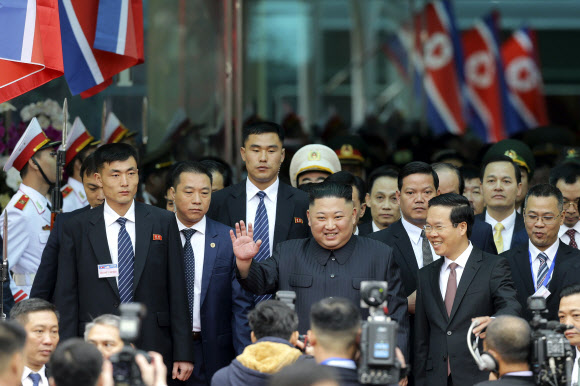 |
|
North Korean leader Kim Jong Un waves upon arrival by train in Dong Dang in Vietnamese border town Tuesday, Feb. 26, 2019, ahead of his second summit with U.S. President Donald Trump. (AP)
|
Observers speculate Kim wanted to avoid appearance of cooperating too closely with China
North Korean leader Kim Jong-un arrived at his accommodations, the Melia Hanoi hotel, on Feb. 26 around 11 am. After his personal, high-security train arrived at Dong Dang railway station in Vietnam’s Lang Song Province earlier that morning, Kim made the remaining 170km journey to Hanoi by car via Highway One. Observers had picked the Melia as the most probable candidate for Kim’s accommodations, as the hotel was being heavily guarded by Vietnamese police and the North Korean protocol and security team that had arrived there two days earlier. Although observers had predicted that Kim would make a stopover in China for a summit with Chinese President Xi Jinping or for a tour of Guangzhou, the center of China’s economic reform and opening, the North Korean leader’s personal train traversed China without any stops. ‘ The rapid journey of Kim’s train was veiled in secrecy. After being spotted at Dandong in Liaoning Province, on the border between North Korea and China, on the evening of Feb. 23, the train passed Tianjin and Shijiazhuang in Hebei Province and then Zhengzhou in Henan Province around midnight on Feb. 24. The train reportedly passed through Wuhan in Hebei Province around 7:20 am on Feb. 25. The train then arrived at Changsha in Hunan Province around 1:10 pm for about 30 minutes of maintenance before setting out again. There had been indications of preparations for the visit of a high-ranking official around Changsha railway station, including announcements that the tracks would be inspected and service interrupted that morning. After leaving Changsha, the train passed the important junction at Hengyang around 3:30 pm and set course not for Guangzhou but for Nanning. Considering that Kim’s train traveled from Dandong to Changsha, a distance of about 2,280km, in some 40 hours, the train’s average speed is estimated to have been a little faster than 60km per hour. A big topic on Chinese social media throughout the day was posts that appeared to be announcements from the railroad authorities indicating that several train services were being canceled for the day on the sections between Changsha and Shimen and between Changsha and Changde in Hunan Province. Regular train service the next morning between Nanning and Pingxiang, which is the final stretch of the journey through China to Vietnam, was also canceled. Kim crossed the border and arrived at Dong Dang railway station in Vietnam’s Lang Song Province at around 8:13 am on Feb. 26. The red carpet was laid out at Dong Dang station on the afternoon of Feb. 25. Over the weekend, the Vietnamese authorities checked the 170km stretch of Highway One running from Dong Dang to Hanoi for landmines and banned vehicular traffic on that road from the afternoon of Feb. 25 until 2 pm on Feb. 26. Still possibility of summit with Xi on way back to North Korea The apparent reason that Kim headed straight for Vietnam without passing through Beijing or Guangzhou was to avoid the appearance of cooperating too closely with China prior to his summit with Trump. But it’s also possible that Kim will meet with Chinese President Xi Jinping on the way home to discuss the results of the summit and other matters. If Kim and Xi hold a fifth summit, Beijing is a leading candidate for the location. Considering that the Lianghui, or two meetings, of the National People’s Congress and the Chinese People’s Political Consultative Conference, which is China’s biggest political event, is set to begin on Mar. 3, Xi is unlikely to leave Beijing at this time. By Kim Oi-hyun, Beijing correspondent Please direct comments or questions to [english@hani.co.kr]






